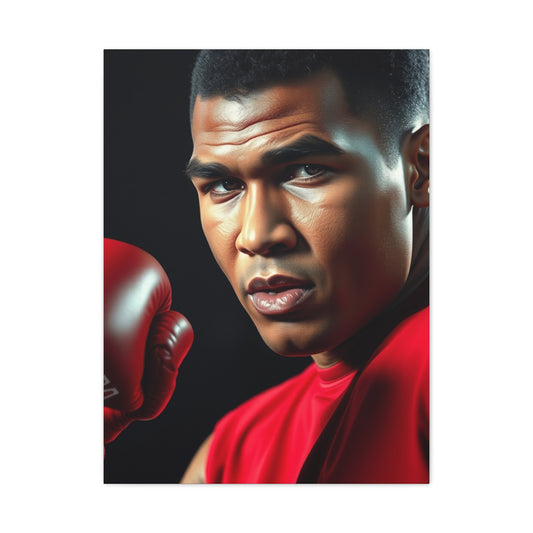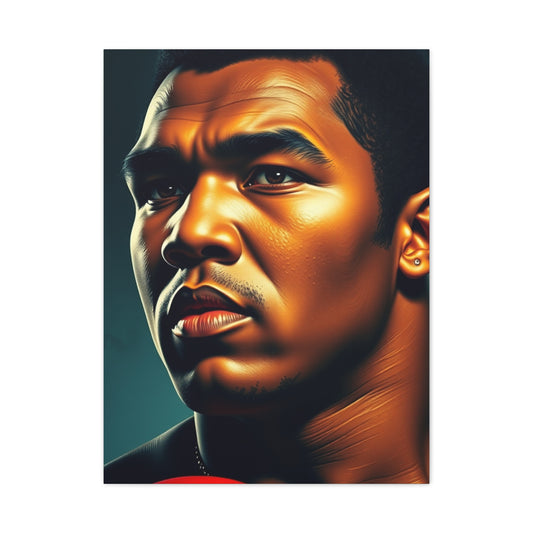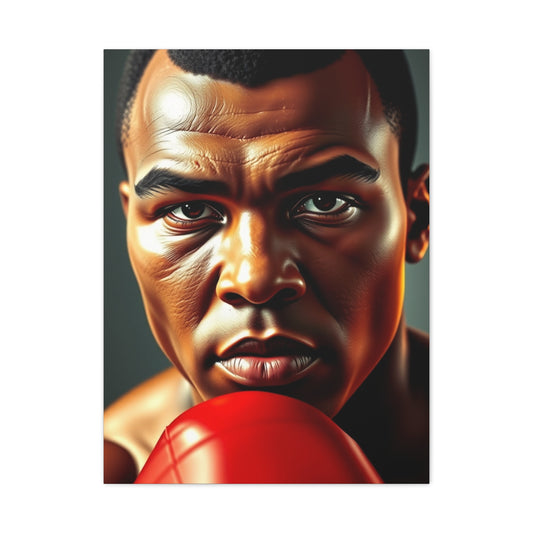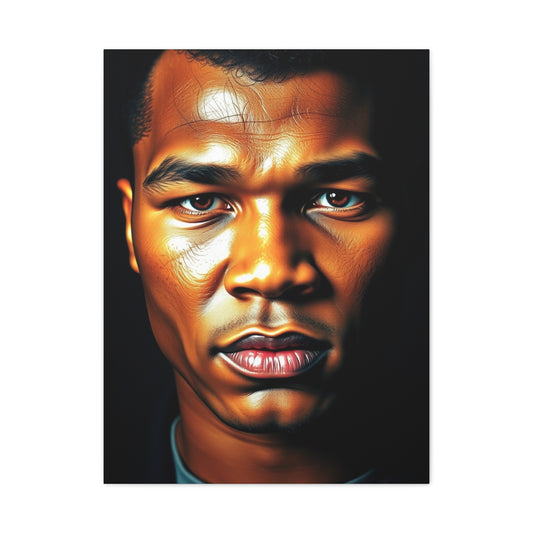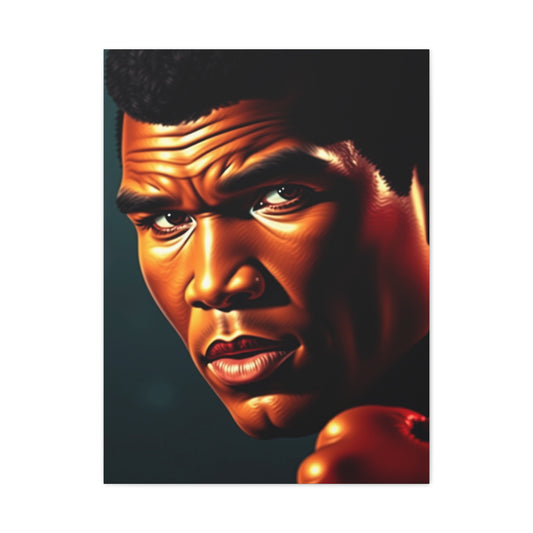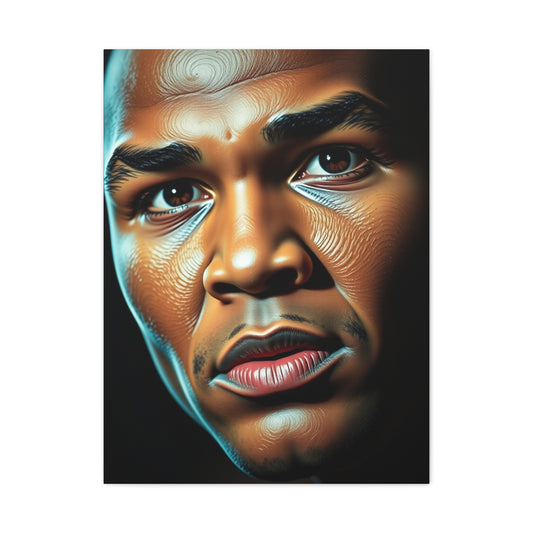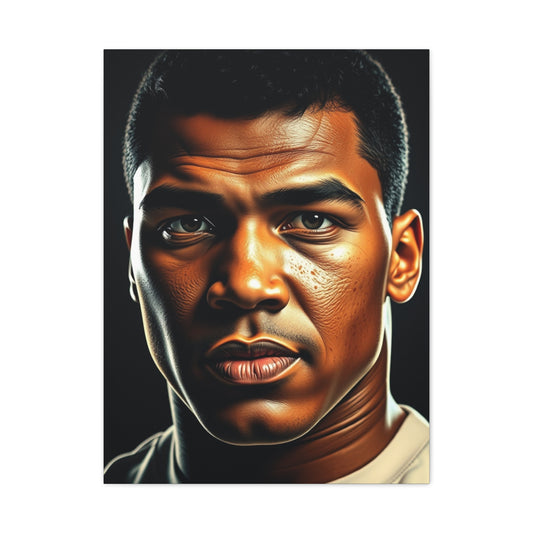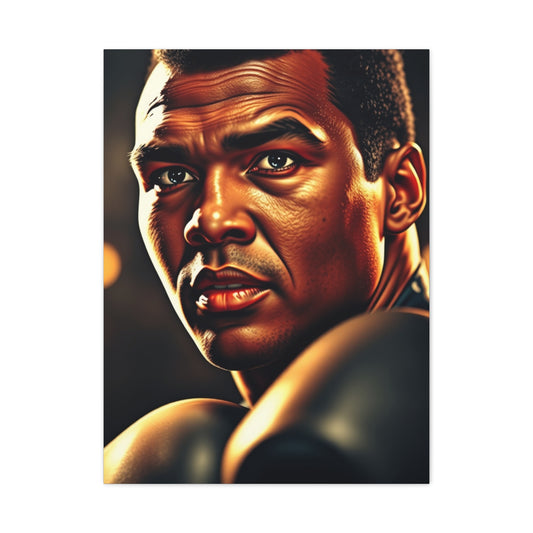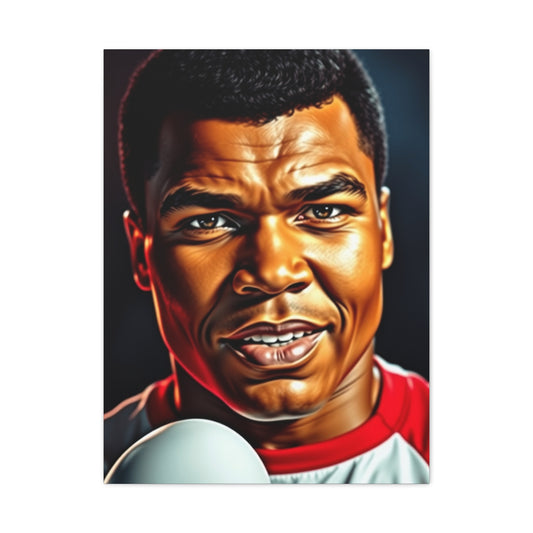Complete Guide to Muhammad Ali Wall Art: Selection, Styles, and Display Tips
Muhammad Ali wall art is more than just decor—it’s a celebration of one of the most iconic and influential athletes in history. Whether you’re a lifelong boxing fan, an admirer of Ali’s civil rights legacy, or simply drawn to powerful imagery, incorporating Ali-inspired art into your space makes a bold statement of strength, resilience, and charisma.
Selection begins with understanding what aspect of Ali’s legacy you want to highlight. Are you drawn to his unforgettable in-ring moments, like the famous knockout of Sonny Liston? Or do you prefer powerful portraits showcasing his confidence and determination? Some collectors opt for minimalist black-and-white photography, while others prefer vibrant, pop-art styles that reflect Ali’s larger-than-life personality.
When it comes to styles, there’s a broad range to choose from: canvas prints, graffiti-inspired murals, typographic posters featuring his quotes, or mixed media artworks that blend photography with painting. Limited edition or hand-signed prints add collectible value, while digital reprints offer affordability and accessibility.
Display tips include choosing a focal point—like a living room wall or home gym—where the artwork commands attention. Complement it with minimalist framing or floating mounts to let the piece shine. Pairing Ali’s image with motivational quotes or memorabilia (like gloves or magazines) can create a dynamic tribute wall.
Ultimately, Muhammad Ali wall art isn’t just decoration—it’s inspiration. With the right selection and thoughtful display, it becomes a timeless tribute to a man who stood for greatness, both inside the ring and far beyond it.
Choosing the Right Ali Wall Art for Your Space
Selecting Muhammad Ali wall art requires careful consideration of your space's dimensions, existing decor, and the emotional impact you want to achieve. The key to choosing the right piece lies in understanding both your environment and the message you want to convey.
Start by assessing your available wall space and measuring the dimensions carefully. Large, dramatic pieces work well as focal points in spacious rooms, while smaller collections can create intimate gallery walls in cozy spaces. Consider the room's lighting conditions, as some Ali artwork features bold contrasts that require adequate illumination to truly shine.
Color coordination plays a crucial role in selection. Muhammad Ali's imagery often features strong blacks, whites, and reds, which can complement both modern and traditional decor schemes. Consider whether you want the artwork to blend harmoniously with existing colors or serve as a striking contrast that commands attention.
The style of your space should influence your choice between photographic prints, painted portraits, abstract interpretations, or mixed-media pieces. Contemporary homes might benefit from sleek, minimalist Ali portraits, while eclectic spaces can accommodate more experimental artistic interpretations.
Think about the room's purpose and the energy you want to create. Ali's fighting poses and intense expressions work well in home gyms or offices where motivation is key, while more contemplative portraits suit living rooms or studies where reflection and inspiration are valued.
Budget considerations are important but shouldn't limit creativity. High-quality prints of famous Ali photographs can be just as impactful as original artwork, and proper framing can elevate any piece's perceived value and longevity.
Pop Art Styles Featuring Muhammad Ali
Pop art's bold colors, graphic elements, and cultural commentary make it a perfect medium for celebrating Muhammad Ali's larger-than-life persona. This artistic movement, which emerged in the 1950s and 1960s alongside Ali's rise to fame, captures the champion's impact on popular culture through vibrant, accessible imagery.
Andy Warhol's influence on Ali pop art cannot be overstated. His silkscreen techniques and repetitive imagery have inspired countless artists to create colorful interpretations of Ali's most famous photographs. These works typically feature high-contrast portraits with electric blues, hot pinks, and neon yellows that make Ali's image pop off the wall.
Contemporary pop artists often incorporate comic book aesthetics into Ali artwork, using Ben-Day dots, bold outlines, and speech bubbles containing his famous quotes. This style particularly appeals to younger audiences and adds a playful energy to any space while maintaining the power of Ali's message.
Digital pop art has opened new possibilities for Ali representations. Artists can now create infinitely customizable color schemes, allowing collectors to match artwork perfectly to their interior design while maintaining the pop art aesthetic. Gradient backgrounds, geometric patterns, and layered compositions add modern flair to classic Ali imagery.
Roy Lichtenstein's influence appears in Ali pop art through the use of primary colors and mechanical reproduction techniques. These pieces often feature Ali in action poses with dramatic speed lines and impact graphics that emphasize his athletic prowess and cultural significance.
The accessibility of pop art makes it an excellent choice for those new to collecting Ali artwork. Mass-produced prints maintain affordability while delivering maximum visual impact, making it possible to create stunning displays without significant investment.
Motivational Muhammad Ali Wall Art Ideas
Muhammad Ali's words and image serve as powerful motivational tools, making his wall art perfect for spaces where inspiration and determination are needed. His famous quotes and triumphant poses can transform any room into a source of daily encouragement and strength.
"Float like a butterfly, sting like a bee" remains one of the most popular motivational Ali quotes for wall art. This phrase works beautifully in gyms, home offices, or anywhere persistence and agility are valued. Typography-based designs featuring this quote can range from elegant script fonts to bold, industrial lettering, each conveying different aspects of Ali's personality.
Training and workout scenes provide excellent motivational imagery. Photographs of Ali jumping rope, hitting the heavy bag, or running through the streets of Miami Beach remind viewers that greatness requires consistent effort and dedication. These images work particularly well in home gyms or exercise rooms where they can provide inspiration during challenging workouts.
Victory poses and championship moments capture Ali's triumphant spirit. Images from his greatest fights, particularly his victories over Sonny Liston and George Foreman, embody the rewards of perseverance and belief in oneself. These pieces work well in offices or study areas where professional or academic challenges are faced daily.
Ali's social justice stance offers profound motivational themes. His courage in standing up for his beliefs, even at great personal cost, inspires artwork that motivates viewers to stand for their convictions. These pieces often incorporate imagery from his anti-war activism and civil rights involvement, providing deeper layers of inspiration beyond athletic achievement.
Composite pieces that combine multiple motivational elements – quotes, action shots, and symbolic imagery – create comprehensive motivational displays. These works tell the complete story of Ali's journey from young Cassius Clay to global icon, providing rich sources of inspiration for overcoming obstacles and achieving dreams.
Display Tips for Ali Wall Art
Proper display techniques can dramatically enhance the impact of Muhammad Ali wall art, transforming good pieces into stunning focal points that capture attention and inspire viewers. Understanding the fundamentals of art display ensures your Ali collection achieves maximum visual and emotional impact.
Height placement is crucial for optimal viewing. The center of your Ali artwork should typically hang at 57-60 inches from the floor, which aligns with average eye level. However, consider the room's function and typical viewing positions – pieces in gyms might hang slightly higher to account for standing exercises, while office pieces should align with seated eye level.
Lighting can make or break Ali wall art display. Natural light should be avoided for valuable prints to prevent fading, but controlled artificial lighting can dramatically enhance visual impact. Track lighting or picture lights can create dramatic shadows that emphasize the contrast in black and white Ali portraits, while even lighting works better for colorful pop art interpretations.
Grouping strategies depend on your collection size and available space. Single, large Ali pieces work best as statement focal points in spacious rooms. For multiple pieces, maintain consistent spacing of 2-3 inches between frames for cohesive gallery walls, or create more dynamic displays with varied spacing that guides the eye through Ali's story chronologically.
Background wall colors significantly affect artwork perception. White or light gray walls provide neutral backgrounds that let Ali's image dominate, while darker walls can create dramatic contrast with lighter pieces. Consider accent walls in colors that complement your Ali art's dominant tones for maximum impact.
Room integration ensures Ali artwork enhances rather than competes with existing decor. Consider the room's style, furniture placement, and traffic flow when positioning pieces. Ali art should feel like a natural part of the space rather than an afterthought, contributing to the room's overall energy and purpose.
Protection from environmental factors extends artwork lifespan. Avoid placing pieces near heat sources, in direct sunlight, or in areas with high humidity. Proper framing with UV-protective glass helps preserve valuable Ali prints for future enjoyment and potential resale value.
Ali Wall Art for Sports Fans
Sports enthusiasts find Muhammad Ali wall art particularly compelling because it represents the pinnacle of athletic achievement combined with cultural significance. Ali's artwork speaks to the dedication, skill, and passion that define true sports appreciation, making it essential for any serious sports fan's collection.
Boxing imagery naturally appeals to combat sports fans, but Ali's artwork transcends specific sports interest. His athletic poses, training scenes, and championship moments embody universal themes of competition, preparation, and victory that resonate with fans of all sports. Action shots from famous fights provide dynamic energy that enhances any sports-themed room.
Team sports fans can appreciate Ali's leadership qualities and team-building philosophy, even though boxing is an individual sport. His ability to inspire others and bring people together around common goals translates well to artwork that celebrates teamwork and collective achievement in sports settings.
Historical sports significance makes Ali artwork valuable for collectors interested in sports history. As a three-time heavyweight champion who competed during boxing's golden era, Ali represents a pivotal period in sports evolution. His fights with Frazier, Foreman, and Norton are legendary moments that sports fans study and celebrate.
Cross-generational appeal ensures Ali artwork connects sports fans of different ages. Older fans remember watching Ali's fights live, while younger fans appreciate his legacy and cultural impact. This makes Ali art excellent for family sports rooms where multiple generations gather to watch games and share sports memories.
Training motivation speaks directly to active sports fans who maintain their own fitness routines. Ali's dedication to training, his famous rope-skipping sessions, and his relentless pursuit of physical perfection provide daily inspiration for sports fans working to improve their own athletic performance.
Sports bar and entertainment area decoration benefits enormously from Ali artwork. His charismatic personality and entertainment value made him perfect for social sports viewing environments. Ali art creates conversation starters and adds authentic sports atmosphere to any gathering space.
DIY Muhammad Ali Art Projects
Creating your own Muhammad Ali wall art allows for personal expression while celebrating the champion's legacy in unique, customized ways. DIY projects offer creative fulfillment and the satisfaction of displaying truly one-of-a-kind pieces that reflect your personal connection to Ali's story and message.
Stencil projects provide an accessible starting point for DIY Ali art. Create stencils from famous Ali silhouettes or quotes, then use spray paint, acrylics, or markers to reproduce the designs on canvas, wood, or walls. This technique works particularly well for bold, graphic interpretations that emphasize Ali's iconic profile or fighting stance.
Photo transfer techniques allow you to incorporate favorite Ali photographs into custom artwork. Using gel medium or transfer paper, you can move Ali images onto wood panels, canvas, or fabric surfaces, then add personal touches with paint, markers, or mixed media elements. This approach creates vintage-style pieces with personal flair.
Typography art featuring Ali's famous quotes offers endless creative possibilities. Hand-lettering, calligraphy, or digital printing can transform inspirational Ali quotes into stunning wall pieces. Experiment with different fonts, sizes, and layouts to create dynamic compositions that emphasize the power of his words.
Collage projects combine multiple Ali images, quotes, and decorative elements into comprehensive artistic statements. Magazine clippings, newspaper articles, photographs, and personal mementos can be arranged and adhered to canvas or poster board, then sealed with protective coating for durability.
Mixed media approaches encourage experimentation with various materials and techniques. Combine painting, drawing, photographs, fabric, and found objects to create layered, textured Ali art that tells complex stories about his life, achievements, and cultural impact. These pieces often become deeply personal expressions of admiration and inspiration.
Upcycling projects transform everyday objects into Ali art displays. Old boxing gloves can become unique wall-mounted sculpture bases for Ali photographs, while vintage magazines featuring Ali can be framed as historical art pieces. This approach combines creativity with sustainability while honoring Ali's legacy.
Black & White Muhammad Ali Portraits
Black and white Muhammad Ali portraits capture the timeless essence of the champion's character and achievements, stripping away color distractions to focus on the power of his expression, the drama of his poses, and the emotional depth of his journey through boxing and social activism.
Classic photography offers the most authentic black and white Ali portraits. Neil Leifer's iconic shots, including the famous image of Ali standing over fallen Sonny Liston, demonstrate how monochrome photography can intensify dramatic moments. These images work exceptionally well in sophisticated interior settings where elegance and historical significance are valued.
High contrast techniques emphasize the sculptural qualities of Ali's face and physique. Strong shadows and bright highlights create dramatic compositions that work particularly well in modern, minimalist settings. These pieces often focus on close-up facial portraits that capture Ali's intensity and determination through careful manipulation of light and shadow.
Pencil and charcoal drawings offer artistic interpretations of Ali that add handmade warmth to black and white portraits. These works often emphasize texture and detail, creating intimate pieces that invite close viewing and contemplation. The organic nature of hand-drawn portraits adds emotional depth that complements Ali's human story.
Print techniques like lithography and etching provide unique textures and tones impossible to achieve through photography alone. These methods create distinctive black and white Ali portraits with artistic qualities that bridge the gap between documentation and fine art, making them valuable additions to serious art collections.
Portrait series work particularly well in black and white format, allowing viewers to trace Ali's evolution from young Olympic champion to elder statesman. Chronological arrangements of black and white portraits tell compelling stories about aging, experience, and the passage of time while maintaining visual cohesion through consistent monochrome treatment.
Contemporary digital techniques allow artists to create new black and white Ali portraits with perfect tonal control and artistic flexibility. Digital manipulation can enhance contrast, adjust composition, and create stylized effects while maintaining the authentic power of the original Ali imagery.
Using Ali Wall Art in Modern Homes
Modern home design principles of clean lines, open spaces, and carefully curated aesthetics provide excellent opportunities for incorporating Muhammad Ali wall art in sophisticated, contemporary ways that honor both the champion's legacy and current design trends.
Minimalist approaches work exceptionally well with Ali imagery. Single, large-scale Ali portraits or quotes can serve as powerful focal points in modern spaces without overwhelming clean, uncluttered environments. The key is selecting pieces that complement rather than compete with modern furniture and architectural elements.
Color coordination becomes crucial in modern settings where neutral palettes dominate. Black and white Ali photographs naturally complement modern color schemes, while carefully selected colorful pieces can provide accent colors that tie together various design elements throughout the room.
Scale considerations are particularly important in modern open-plan living spaces. Large-format Ali prints can help define different areas within open floor plans, while smaller pieces work well in more intimate spaces like reading nooks or home offices integrated into larger living areas.
Technology integration offers opportunities to display Ali artwork through digital frames and projection systems. Rotating collections of Ali images can provide dynamic, changing focal points that maintain visual interest while allowing for seasonal or mood-based adjustments to the home's aesthetic.
Architectural integration takes advantage of modern homes' structural elements. Built-in display niches, floating shelves, and gallery lighting systems can be designed specifically to showcase Ali artwork as integral parts of the home's architecture rather than afterthoughts.
Furniture coordination ensures Ali artwork enhances rather than conflicts with modern furnishings. Contemporary frames, mounting systems, and display methods should complement modern furniture styles while allowing the artwork's historical and cultural significance to shine through.
Muhammad Ali Wall Art for Gyms
Gym environments benefit tremendously from Muhammad Ali wall art because his image and words embody the dedication, perseverance, and mental toughness required for serious fitness training. Ali's presence in workout spaces provides constant motivation and inspiration for pushing through physical and mental barriers.
Motivational quotes work exceptionally well in gym settings where people need encouragement during challenging workouts. Ali's famous sayings like "I hated every minute of training, but I said, 'Don't quit. Suffer now and live the rest of your life as a champion'" speak directly to anyone struggling through difficult exercise routines.
Action photography showing Ali in training provides visual inspiration for proper form and intense effort. Images of Ali jumping rope, hitting the heavy bag, or doing roadwork demonstrate the training commitment required for excellence. These pieces work particularly well near specific equipment areas where similar exercises are performed.
Size considerations for gym spaces typically favor larger pieces that can be seen clearly from various exercise positions and distances. Bold, high-contrast images work well in environments where people are moving and may only catch glimpses of artwork between exercises or while transitioning between equipment.
Durability becomes crucial in gym environments with higher humidity, temperature fluctuations, and potential for impact. Proper framing with moisture-resistant materials and shatterproof glazing protects artwork while ensuring safety. Laminated prints or canvas pieces often work better than paper prints in these conditions.
Placement strategies should consider gym traffic flow and safety requirements. Artwork should never interfere with emergency exits, ventilation systems, or equipment operation. Strategic placement can actually enhance gym navigation by providing visual landmarks and breaking up large wall spaces in pleasant ways.
Multiple piece arrangements work well in gyms because they can tell the complete story of Ali's training philosophy and achievements. Sequential images showing different aspects of his preparation and competition create comprehensive motivational displays that support various types of workouts and fitness goals.
Bold vs. Minimalist Ali Wall Art
The choice between bold and minimalist approaches to Muhammad Ali wall art depends on your space, personality, and the specific impact you want to achieve. Both styles offer unique advantages and can effectively honor Ali's legacy while serving different aesthetic and functional purposes.
Bold Ali artwork commands attention through vivid colors, dramatic compositions, and intense emotional content. Pop art interpretations with electric blues, hot pinks, and neon yellows create energetic focal points that energize spaces and reflect Ali's larger-than-life personality. These pieces work well in social areas where conversation and interaction are encouraged.
High-contrast bold pieces often feature Ali's most dynamic poses and expressions, capturing the intensity of his fighting spirit and charismatic personality. These works typically use strong lighting, dramatic shadows, and exaggerated features to create maximum visual impact and emotional response.
Multiple bold pieces can create immersive environments that surround viewers with Ali's energy and presence. Gallery walls featuring various colorful interpretations, action shots, and quote-based designs can transform entire rooms into celebrations of Ali's life and achievements.
Minimalist Ali art takes opposite approaches, using restraint and simplicity to create sophisticated, contemplative pieces. Clean lines, limited color palettes, and carefully chosen imagery create artwork that invites quiet reflection and deep appreciation for Ali's legacy.
Single-element minimalist pieces might feature only Ali's silhouette, a famous quote in simple typography, or a close-up detail from a famous photograph. These works rely on powerful simplicity rather than visual complexity to create emotional connections with viewers.
Negative space utilization in minimalist Ali art allows the champion's image or words to breathe and command attention through isolation rather than competition with other visual elements. This approach works particularly well in modern, sophisticated interior settings.
Famous Ali Wall Art Artists
Understanding the artists who have created significant Muhammad Ali wall art helps collectors and enthusiasts appreciate different artistic interpretations while making informed decisions about their own collections. These artists bring unique perspectives and techniques to Ali's image and legacy.
LeRoy Neiman stands out as perhaps the most famous artist associated with Ali artwork. His energetic, impressionistic paintings captured Ali's movement and personality in vibrant, dynamic compositions that became iconic representations of the champion. Neiman's work bridges fine art and sports illustration, creating pieces that appeal to both art collectors and sports fans.
Neil Leifer's photography provides the foundation for many Ali art pieces, even those created by other artists. His dramatic sports photography, including the famous overhead shot of Ali standing over Sonny Liston, has been reproduced, reinterpreted, and referenced countless times in various artistic media.
Andy Warhol's influence on Ali artwork extends beyond his direct portraits of the champion. His silkscreen techniques and pop art aesthetic have inspired numerous artists to create Warhol-influenced Ali pieces that combine commercial art techniques with fine art sensibilities.
Contemporary street artists like Shepard Fairey have created powerful Ali artwork that connects his athletic achievements with social justice themes. These works often use graphic design techniques and political art aesthetics to emphasize Ali's role as both sports figure and cultural activist.
Howard Bingham, Ali's personal photographer and close friend, created intimate portraits that reveal Ali's private personality alongside his public persona. These works provide source material for artists seeking to capture Ali's human side rather than just his athletic achievements.
Digital artists working in contemporary media have created new categories of Ali artwork using computer graphics, photo manipulation, and mixed media techniques. These artists often combine historical Ali imagery with modern artistic techniques to create pieces that speak to contemporary audiences while honoring traditional representation.
The Power of Ali Wall Art Quotes
Muhammad Ali's eloquent, powerful words provide rich source material for typography-based wall art that inspires, motivates, and challenges viewers. His quotes capture not only his confidence and competitive spirit but also his wisdom, humor, and profound insights into life, justice, and human potential.
"Float like a butterfly, sting like a bee" remains the most popular Ali quote for wall art, encapsulating his fighting philosophy in poetic language that applies to many life situations. Typography treatments of this quote range from elegant script fonts that emphasize its lyrical quality to bold, aggressive lettering that highlights its competitive edge.
"I am the greatest" represents Ali's supreme self-confidence and his understanding that believing in yourself is the first step toward achieving greatness. This quote works particularly well in offices, studios, and personal spaces where self-motivation and confidence-building are important goals.
"Service to others is the rent you pay for your room here on earth" showcases Ali's philosophical depth and commitment to helping others. This quote appeals to people interested in Ali's humanitarian work and social consciousness, making it perfect for spaces dedicated to service, education, or reflection.
"Don't count the days, make the days count" offers timeless wisdom about living purposefully and making the most of every opportunity. This quote works well in various settings where productivity, mindfulness, and intentional living are valued.
"Impossible is just an opinion" challenges viewers to reconsider their limitations and push beyond perceived boundaries. This motivational message works effectively in gyms, offices, and anywhere people face challenges or work toward ambitious goals.
Typography design choices dramatically affect how Ali's quotes impact viewers. Sans-serif fonts convey modernity and strength, while serif fonts add elegance and tradition. Hand-lettered styles create personal, intimate feelings, while bold, industrial fonts emphasize power and determination.
Affordable Muhammad Ali Wall Art Picks
Building an impressive Muhammad Ali wall art collection doesn't require enormous budgets when you know where to look and how to maximize value. Many affordable options provide excellent quality and visual impact while honoring Ali's legacy authentically.
High-quality prints of famous Ali photographs offer the best starting point for budget-conscious collectors. Many iconic images are available as licensed prints through legitimate sources, providing authentic reproductions at reasonable prices. These prints often look indistinguishable from expensive originals when properly framed and displayed.
Digital downloads provide immediate access to Ali artwork at minimal cost. Many artists and photographers offer high-resolution files that can be printed at local shops or home printers, allowing collectors to choose their own paper quality and size specifications while maintaining budget control.
Poster formats make Ali artwork accessible to anyone while still providing powerful visual impact. Modern poster printing techniques create durable, attractive pieces that work well in casual settings, dorm rooms, offices, and anywhere affordable art is needed.
DIY framing significantly reduces overall artwork costs while allowing for personal customization. Purchasing quality frames separately and assembling displays yourself can cut total costs by 50% or more compared to professionally framed pieces, while still achieving professional-looking results.
Thrift stores and estate sales sometimes yield unexpected Ali artwork finds at bargain prices. Vintage magazines featuring Ali, old posters, and forgotten prints can be discovered by persistent searchers, often requiring only cleaning and proper framing to become attractive display pieces.
Online marketplaces provide access to both new and used Ali artwork from sellers worldwide. Careful shopping and patience often reveal excellent deals on quality pieces, though buyers should verify authenticity and condition before purchasing expensive items.
Limited Edition Ali Prints to Watch
Limited edition Muhammad Ali prints represent the intersection of artistic value and collectible investment, offering serious collectors opportunities to own exclusive artwork while potentially building valuable collections that appreciate over time.
Numbered lithographs by established artists command premium prices but offer authenticated provenance and potential appreciation. These prints typically feature certificates of authenticity, artist signatures, and clear documentation of edition sizes, making them attractive to serious collectors and investors.
Anniversary editions celebrating significant Ali milestones often become valuable collectibles. Prints commemorating famous fights, Olympic achievements, or important dates in Ali's life typically have strong market appeal and clear historical significance that supports long-term value.
Photographer estate releases sometimes make previously unavailable images accessible as limited edition prints. When famous sports photographers' estates release archived Ali images as authorized prints, they often become highly sought-after collectibles due to their rarity and historical significance.
Artist collaboration pieces, where contemporary artists reinterpret classic Ali imagery, create unique limited editions that appeal to both sports fans and contemporary art collectors. These works often combine traditional Ali imagery with modern artistic techniques and sensibilities.
Boxing Hall of Fame and museum store exclusives provide access to officially sanctioned limited edition prints that carry institutional credibility and authentication. These pieces often commemorate specific exhibitions or anniversaries, adding historical context to their collectible appeal.
Regional editions celebrating Ali's connections to specific locations, like Louisville or Miami, often develop strong local collector markets while appealing to broader audiences interested in Ali's geographical history and cultural impact.
Muhammad Ali Wall Art for Kids' Rooms
Muhammad Ali wall art in children's rooms serves multiple purposes: decoration, inspiration, and education about an important historical figure who embodied positive values like determination, courage, and standing up for beliefs.
Age-appropriate imagery focuses on Ali's positive attributes rather than violent fighting scenes. Images of Ali training, smiling, holding his Olympic gold medal, or interacting with children provide inspiring examples without potentially disturbing content for young viewers.
Educational components can be integrated into kids' Ali artwork through timeline pieces, biographical information, and historical context that help children understand Ali's significance beyond boxing. These elements transform wall art into learning opportunities that spark curiosity and discussion.
Bright, colorful interpretations appeal to children's aesthetic preferences while maintaining Ali's inspirational message. Cartoon-style illustrations, pop art treatments, and playful graphic designs can make Ali's image engaging and accessible to young audiences without compromising the respect due to his legacy.
Interactive elements like removable quotes, magnetic components, or write-on surfaces allow children to engage with Ali artwork actively. These features encourage children to think about Ali's messages and apply his lessons to their own challenges and goals.
Growth tracking charts featuring Ali imagery provide functional artwork that serves practical purposes while inspiring children to reach their potential. Ali's own journey from young amateur to world champion provides an excellent metaphor for personal growth and development.
Safety considerations for children's rooms require attention to mounting methods, frame materials, and artwork placement. All pieces should be securely attached and positioned where they won't pose hazards during active play or cause injury if accidentally contacted.
Street Art Inspired by Muhammad Ali
Street art interpretations of Muhammad Ali reflect his status as a people's champion and cultural icon, bringing his image and message to public spaces where they can inspire and educate broader audiences while connecting with contemporary urban art movements.
Mural traditions in Ali's hometown of Louisville have created numerous large-scale street art tributes that celebrate his local roots while acknowledging his global impact. These works often incorporate neighborhood themes and community values alongside Ali's athletic achievements.
Graffiti-style Ali art appears in cities worldwide, demonstrating his international appeal and the universal nature of his message. These works often use spray paint techniques, bold lettering, and urban aesthetics to present Ali in contemporary street art contexts.
Stencil art featuring Ali's silhouette or quotes provides a quick, reproducible method for sharing his image in public spaces. The graphic simplicity required for stencil work often creates powerful, iconic representations that capture Ali's essence effectively.
Political messaging in Ali street art emphasizes his role as a social activist and conscience of his era. These works often connect Ali's anti-war stance and civil rights involvement with contemporary social justice movements, maintaining relevance for new generations.
Community engagement projects involving Ali street art provide opportunities for neighborhood involvement in creating public art. These collaborative efforts often result in meaningful community expressions that honor Ali while addressing local concerns and values.
Permission and legal considerations vary widely for street art projects. Some Ali street art appears without authorization, while other projects receive official sanction from property owners, municipalities, or cultural organizations seeking to honor Ali's legacy through public art.
Framing Ideas for Ali Wall Art
Proper framing dramatically enhances Muhammad Ali wall art while protecting valuable pieces from damage and environmental factors. The right frame choices complement both the artwork and the surrounding decor while ensuring long-term preservation and visual impact.
Traditional framing approaches work well with classic Ali photography and formal portraits. Rich wood frames in mahogany, walnut, or cherry complement the historical significance of vintage Ali images while adding elegance to formal settings. These frames often feature traditional profiles and finishes that emphasize craftsmanship and quality.
Modern framing styles suit contemporary Ali interpretations and minimalist settings. Sleek metal frames in black, silver, or white provide clean lines that don't compete with bold artwork while offering contemporary aesthetics that work well in modern homes and offices.
Matting choices significantly affect artwork presentation and preservation. White or cream mats provide neutral backgrounds that make Ali images pop, while colored mats can coordinate with room decor or artwork elements. Multiple mat layers create depth and sophistication while increasing the piece's apparent size and importance.
Shadow box framing works excellently for three-dimensional Ali memorabilia or mixed-media artwork. These deeper frames accommodate objects like boxing gloves, tickets, or personal items alongside photographs or artwork, creating comprehensive tributes to Ali's legacy.
Gallery framing techniques used in museums and professional exhibitions can be adapted for home use. These methods emphasize archival materials, UV protection, and conservation principles that ensure long-term preservation while maintaining professional appearance standards.
DIY framing options allow budget-conscious collectors to achieve professional results while maintaining control over materials and costs. Modern framing supplies and online tutorials make it possible to create museum-quality presentations at home with patience and attention to detail.
How Ali Wall Art Boosts Motivation
Muhammad Ali wall art serves as a powerful motivational tool because it combines visual inspiration with the psychological impact of Ali's extraordinary achievements and inspiring philosophy. His image and words provide daily reminders of what's possible when determination meets opportunity.
Visual anchoring creates psychological connections between Ali's success and viewers' goals. Seeing Ali's image regularly while working toward personal objectives helps establish mental associations between effort and achievement, making the artwork a catalyst for sustained motivation and focus.
Quote power multiplies when Ali's words are visible during challenging moments. His famous sayings about perseverance, self-belief, and overcoming obstacles provide immediate access to motivational wisdom exactly when it's needed most, whether during workouts, work challenges, or personal struggles.
Role model imagery helps viewers visualize success and maintain focus on long-term goals. Ali's transformation from young Cassius Clay to world champion provides a compelling example of how dedication and hard work lead to extraordinary achievements, inspiring similar commitment in observers.
Daily reinforcement through consistent exposure to Ali artwork gradually shapes mindset and behavior patterns. Regular visual reminders of Ali's principles and achievements help maintain motivation over time, supporting sustained effort toward challenging goals rather than just momentary inspiration.
Emotional connection with Ali's story creates deeper, more lasting motivational effects than generic inspirational content. His specific struggles, victories, and life philosophy resonate with people facing their own challenges, making his artwork personally meaningful and emotionally powerful.
Environmental psychology suggests that surrounding ourselves with inspiring imagery influences mood, energy levels, and performance. Ali artwork creates positive environmental cues that support motivation and achievement-oriented mindsets throughout daily activities.
Digital Muhammad Ali Art Trends
Digital technology has revolutionized Muhammad Ali artwork creation and distribution, enabling new artistic expressions while making Ali's image more accessible to global audiences through various online platforms and digital media formats.
NFT (Non-Fungible Token) Ali artwork represents the newest frontier in digital collecting, offering unique ownership of digital Ali art pieces. These blockchain-verified artworks provide new ways for artists to create and sell Ali-inspired pieces while giving collectors authenticated ownership of digital assets.
Digital manipulation techniques allow artists to create surreal, impossible Ali imagery that goes beyond traditional photography limitations. These works might combine multiple time periods, impossible perspectives, or fantastical elements while maintaining recognizable Ali imagery as their foundation.
Interactive digital art featuring Ali responds to viewer input through motion sensors, touch screens, or mobile device integration. These pieces might reveal hidden information, change based on viewer proximity, or allow customization of colors, quotes, or other elements.
Augmented reality applications bring Ali artwork to life through smartphone and tablet interfaces. Viewers can point devices at static Ali artwork to reveal additional information, animations, or interactive elements that enhance the traditional art viewing experience.
Social media art sharing has created new platforms for discovering and sharing Ali artwork. Instagram, Pinterest, and other visual platforms enable artists to reach global audiences while allowing collectors to discover new pieces and connect with other Ali art enthusiasts.
Print-on-demand technology makes digital Ali artwork immediately available as physical products. Artists can create digital designs that customers can order as canvas prints, posters, or other formats, eliminating inventory requirements while providing instant access to new artwork.
Ali Wall Art and Social Justice Themes
Muhammad Ali's commitment to social justice and civil rights makes his wall art particularly meaningful for those who value equality, activism, and standing up for moral principles. His artwork often incorporates themes that remain relevant to contemporary social movements and justice advocacy.
Civil rights imagery featuring Ali connects his boxing success with his broader role in America's struggle for racial equality. Artwork depicting Ali with other civil rights leaders or incorporating civil rights symbols creates powerful statements about the intersection of sports and social change.
Anti-war messaging in Ali artwork recalls his principled stand against the Vietnam War, which cost him prime years of his boxing career but established him as a moral leader willing to sacrifice personal gain for deeply held beliefs. These pieces resonate with viewers who face their own moral choices and social pressures.
Religious freedom themes appear in Ali artwork that addresses his conversion to Islam and his commitment to religious principles even when they conflicted with popular opinion. These works speak to contemporary discussions about religious tolerance and the courage required to live according to one's beliefs.
Prison abolition and criminal justice reform connect to Ali's legal struggles and his understanding of how the justice system can be used to punish those who challenge authority. Contemporary artists often draw parallels between Ali's experiences and current criminal justice issues.
International peace messaging builds on Ali's later role as a global ambassador and peace advocate. Artwork depicting Ali's diplomatic missions and humanitarian work emphasizes his evolution from controversial figure to respected global statesman committed to peaceful resolution of conflicts.
Contemporary relevance ensures that Ali social justice artwork remains meaningful to new generations facing similar struggles for equality and justice. Modern artists often explicitly connect Ali's historical activism with current movements, maintaining his relevance for contemporary audiences.
Conclusion:
Muhammad Ali wall art is far more than a visual homage to a boxing legend—it is a powerful reflection of cultural history, personal conviction, and artistic expression. As both an athlete and activist, Ali’s legacy transcends sports, making his image a symbol of courage, resilience, and the fight for justice. Choosing to display Ali-inspired artwork is not just about aesthetics; it is a meaningful way to honor a figure who challenged the world to think, to act, and to believe in something greater.
From bold canvas prints capturing Ali's iconic victories to thought-provoking pieces featuring his most memorable quotes, this art captures the essence of who he was—a fearless champion, an eloquent speaker, and a man of unshakable principle. Each style, whether modern or vintage, minimalist or vivid, offers a unique interpretation of Ali’s persona, allowing admirers to connect with different facets of his legacy. Whether you're drawn to his athletic prowess, his political stance, or his charismatic spirit, there's a piece of Muhammad Ali art that speaks directly to your inspiration.
Displaying such artwork in your home, office, or personal space can serve as a daily reminder of the values Ali embodied—discipline, confidence, integrity, and perseverance. It transforms a simple wall into a source of motivation and reflection. When thoughtfully selected and placed, Muhammad Ali wall art becomes a powerful centerpiece that resonates beyond its visual appeal.
In the end, incorporating Muhammad Ali into your environment through art ensures that his message lives on—not just in history books or highlight reels, but in the very spaces where we live, work, and grow. It is a timeless tribute to a man who truly was, and will forever be, The Greatest.

